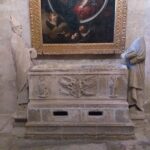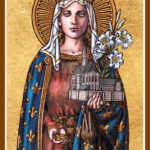St. Juan Diego
St. Juan Diego
St. Juan Diego
When they lived:
St. Juan Diego lived during the early 16th century.
Where they lived:
Juan Diego was a native of Cuauhtitlan, a small village located near present-day Mexico City.
Notable world events during the time of their life:
- 1492 – Columbus’ Voyage: Christopher Columbus discovers the Americas, connecting the Old World and the New World.
- 1517 – The Protestant Reformation Begins: Martin Luther initiates a religious movement that challenges the Catholic Church’s authority.
- 1519 – Magellan’s Circumnavigation: Ferdinand Magellan’s expedition leads to the first successful circumnavigation of the Earth.
- 1521 – Fall of the Aztec Empire: Spanish conquistadors, led by Hernan Cortes, conquer the Aztec Empire, profoundly affecting the indigenous cultures of the region.
Patronage:
St. Juan Diego is the patron saint of indigenous peoples in the Americas and is revered as the first indigenous American saint. He symbolizes faith, perseverance, and intercession.
A Convert to the Faith
Prior to his conversion to the Catholic faith, little is known about Juan Diego’s life. However, tradition, archaeological, and iconographic sources, including “El Nican Mopohua,” which is the oldest and most important indigenous document about the event of Guadalupe, give us some information about the life of the saint and the apparitions of the Virgin Mary.
Juan Diego was born in 1474 in Cuautlitlan, a part of modern-day Mexico City. He was a privileged member of the Chichimeca people, a more culturally advanced group in the Anáhuac Valley. When he was 50 years old, Juan Diego was baptized by Fr. Peter de Gand, one of the first Franciscan missionaries. From then on, he has shown deep piety and devotion, especially to the Mass.
The Lady’s Request
On his way to attend Mass on December 9, 1531, he was stopped by the beautiful sight of a radiant woman who introduced herself, in his native tongue, as the “ever-perfect holy Mary, who has the honor to be the mother of the true God”. The Blessed Mother appeared to him on Tepeyac Hill, located on the outskirts of what is now Mexico City. She asked him to go to the bishop and plead in her name that a shrine be built at Tepeyac, with the promise to pour out her grace upon those who call upon her. Juan Diego adhered to the lady’s request and went to Bishop Juan de Zumarraga.
The bishop, who did not believe Juan Diego’s story, asked for a sign to prove that what he had seen was true. On December 12, Juan Diego went back to Tepeyac. The Blessed Mother appeared to him and told him to climb the hill and to pick the flowers that he would find in bloom. He obeyed the Blessed Mother’s command. It was winter, but he found roses flowering! He picked the flowers, gathered them, and took them to Our Lady. She then carefully placed them on his mantle and told him to bring them to the bishop as his requested “proof”. In the presence of the bishop, he opened the mantle. The flowers fell on the ground, and there remained, instead of the flowers, an image of the Blessed Mother, the very apparition at Tepeyac.
The lady was his reward.
With the bishop’s permission, Juan Diego lived as a hermit in a small hut near the chapel where the miraculous image was placed for veneration. He cared for that church and the pilgrims who came to pray to the Blessed Mother. After living a life dedicated to prayer, the practice of virtue, and the love of God and neighbor, Juan Diego died in 1548. He was buried in the first chapel dedicated to the Virgin of Guadalupe. He was beatified on May 6, 1990, by Pope John Paul II at the Basilica of Santa Maria di Guadalupe in Mexico City. On July 31, 2002, he was canonized as a saint by Pope John Paul II. His feast day is December 9.
Five Interesting Facts About St. Juan Diego
- Before he was converted to the faith, St. Juan Diego’s name was “Cuauhtlatoatzin”, which means “the talking eagle”.
- From the age of three, St. Juan Diego was raised in the Aztec pagan religion but always showed signs of having a mystical sense of life.
- St. Juan Diego was the first indigenous saint from the Americas and is the patron of indigenous people.
- St. Juan Diego’s uncle was miraculously healed by the Virgin. He also explained that he, too, saw the Virgin Mary. She also instructed him on her desires to have a church built on Tepeyac Hill, but she also told him she wanted to be known with the title of Guadalupe.
- The first miracle surrounding the cloak happened during a procession to Tepeyac Hill. One of the participants was shot in the throat by an arrow. The man was healed after being placed in front of the miraculous image of Guadalupe.
Prayer to St. Juan Diego
O God, who by means of Saint Juan Diego showed the love of the most holy Virgin Mary for your people, grant, through his intercession, that, by following the counsels our Mother gave at Guadalupe, we may be ever constant in fulfilling your will. Through our Lord Jesus Christ, your Son, who lives and reigns with you in the unity of the Holy Spirit, one God, for ever and ever Amen.



